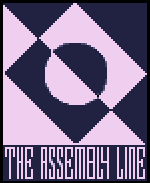Difference between revisions of "The Assembly Line"
From Sega Retro
m (Text replacement - "| tseries= |" to "|") |
|||
| (20 intermediate revisions by 4 users not shown) | |||
| Line 1: | Line 1: | ||
| − | {{ | + | {{CompanyBob |
| logo=The Assembly Line Logo.png | | logo=The Assembly Line Logo.png | ||
| − | + | | founded=1988-11{{magref|nextgeneration|6|51}}{{magref|amigaformat|8|10}} | |
| − | | founded= | ||
| defunct=19xx | | defunct=19xx | ||
| − | |||
| mergedwith= | | mergedwith= | ||
| mergedinto= | | mergedinto= | ||
| Line 10: | Line 8: | ||
}} | }} | ||
| − | {{sub-stub}}'''''{{PAGENAME}}'''''{{ | + | {{sub-stub}}'''''{{PAGENAME}}'''''{{magref|amigaformat|8|10}} was a British video game development company, founded in November 1988, in Bristol, England by a group of developers composed by John Dale (later replaced by Portuguese programmer and video game designer [[Ricardo Pinto]]{{magref|amigapower|4|62}}{{magref|amigapower|4|63}}{{ref|https://www.ricardopinto.com/about/}}{{ref|https://web.archive.org/web/20190616142021/http://birdsanctuary.co.uk/ept/2/}}, designer of the 1996 [[Mega Drive]] game ''[[Nightmare Circus]]'', formerly of Rainbird Software, a sister company of Firebird Software, two labels of [[wikipedia:Telecomsoft|Telecomsoft]], after John left the company), Martin Day (a.k.a Spiny Norman, co-founder of [[SN Systems]]), Andy Beveridge (former [[Realtime Games Software]] programmer{{magref|nextgeneration|6|51}} and [[SN Systems]] co-founder) and [[Adrian Stephens]]. |
| + | |||
| + | The company was involved in writing games for the [[Commodore 64]], [[Atari ST]] and [[Amiga]] computers and was known for their excellent programming skills which were technically more refined than most of other contemporary video game development companies, especially in the area of 3D graphics{{magref|amigapower|4|62}}{{magref|amigapower|4|63}}{{magref|amigaformat|23|33}}{{magref|amigaformat|23|34}}{{magref|amigaformat|23|35}}{{magref|amigaformat|23|37}}{{magref|amigaformat|23|38}}. The video game [[Xenon 2: Megablast]], which was designed by [[The Bitmap Brothers]] and published by [[Imageworks]] originally for the [[Amiga]] and [[Atari ST]] computers and later ported to other platforms including the [[Mega Drive]] and [[Master System]] consoles, was programmed{{magref|nextgeneration|6|51}} by them (Martin Day assumed the task of programming the game, since John Smith{{magref|one|8|28}} the original programmer was having difficulties in coding the game). | ||
==Softography== | ==Softography== | ||
| − | + | {{CompanyHistoryAll|The Assembly Line}} | |
| − | |||
| − | |||
| − | |||
| − | |||
==References== | ==References== | ||
<references /> | <references /> | ||
| + | {{TheTitle}} | ||
[[Category:Third-party software developers]] | [[Category:Third-party software developers]] | ||
Latest revision as of 13:53, 19 March 2024

| ||
| The Assembly Line | ||
|---|---|---|
| Founded: 1988-11[1][2] | ||
| Defunct: 19xx | ||
Headquarters:
|
This teeny-tiny article needs some work. You can help us by expanding it.
The Assembly Line[2] was a British video game development company, founded in November 1988, in Bristol, England by a group of developers composed by John Dale (later replaced by Portuguese programmer and video game designer Ricardo Pinto[3][4][5][6], designer of the 1996 Mega Drive game Nightmare Circus, formerly of Rainbird Software, a sister company of Firebird Software, two labels of Telecomsoft, after John left the company), Martin Day (a.k.a Spiny Norman, co-founder of SN Systems), Andy Beveridge (former Realtime Games Software programmer[1] and SN Systems co-founder) and Adrian Stephens.
The company was involved in writing games for the Commodore 64, Atari ST and Amiga computers and was known for their excellent programming skills which were technically more refined than most of other contemporary video game development companies, especially in the area of 3D graphics[3][4][7][8][9][10][11]. The video game Xenon 2: Megablast, which was designed by The Bitmap Brothers and published by Imageworks originally for the Amiga and Atari ST computers and later ported to other platforms including the Mega Drive and Master System consoles, was programmed[1] by them (Martin Day assumed the task of programming the game, since John Smith[12] the original programmer was having difficulties in coding the game).
Softography
References
- ↑ 1.0 1.1 1.2 Next Generation, "June 1995" (US; 1995-05-23), page 51
- ↑ 2.0 2.1 Amiga Format, "March 1990" (UK; 1990-0x-xx), page 10
- ↑ 3.0 3.1 Amiga Power, "August 1991" (UK; 1991-07-25), page 62
- ↑ 4.0 4.1 Amiga Power, "August 1991" (UK; 1991-07-25), page 63
- ↑ https://www.ricardopinto.com/about/
- ↑ http://birdsanctuary.co.uk/ept/2/ (Wayback Machine: 2019-06-16 14:20)
- ↑ Amiga Format, "June 1991" (UK; 1991-0x-xx), page 33
- ↑ Amiga Format, "June 1991" (UK; 1991-0x-xx), page 34
- ↑ Amiga Format, "June 1991" (UK; 1991-0x-xx), page 35
- ↑ Amiga Format, "June 1991" (UK; 1991-0x-xx), page 37
- ↑ Amiga Format, "June 1991" (UK; 1991-0x-xx), page 38
- ↑ The One, "May 1989" (UK; 1989-04-xx), page 28